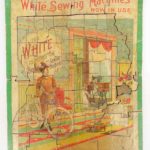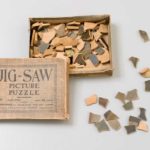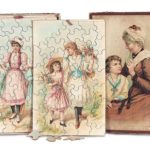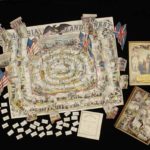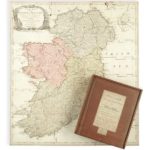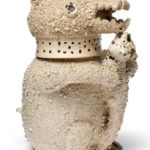Dissected puzzles were the forerunners of jigsaws. They were very simply made by placing a picture on a piece of wood and cutting it into shapes. Some pieces might interlock, but most of the puzzle was just pushed into place. This meant that it would not stay in one piece very easily. To solve this, the outer edges of some puzzles, like this example, had long interlocking pieces that would hold the whole puzzle together. The reverse of this puzzle has a map of England and Wales. It was quite common for a puzzle to have two sides. These were called double dissection. Reference: Victoria and Albert Museum
Dissected puzzles are very collectible and there are some beautiful examples. Values of dissected puzzles depend on condition plus subject matter.
Below are some examples and price guides of some dissected puzzles including a John Spilsbury puzzle and a boxed set of Victorian puzzles with pictures of children in Victorian dress.
SPILSBURY, John (1739-1769). Europe divided into its Kingdoms. London: J. Spilsbury, [c.1766]. A very rare example of the earliest known jigsaw puzzle, in remarkably fine and near-complete condition.
Sold for GBP 5,000 at Christie’s in 2018
Ohio, Dissected paper on wood puzzle map. Published by C.E. Hartman, Utica, N.Y. Successor of Rev. E.J. Clemens. Late 19th C.
Sold for $125 at Copake Auction Inc. in 2020
Parker Bros jigsaw puzzle, ‘Peasant Mother’
This is an early hand-cut solid wood “Jig-Saw Picture Puzzle” of 108 pieces entitled “Mother Love” or “The Peasant Mother” made by the American firm, Parker Brothers of Salem, Massachusetts, between 1906 and 1914. It was produced at a time when puzzles were actually made for adults. The pieces do not interconnect nor is there a guide picture on the cover of the box. These early puzzles were expensive as they had to be cut one piece at a time.
Reference: Museum of Applied Art and Sciences
BOXED SET OF PUZZLES IN THE VICTORIAN THEME
12″ (30 cm.) A heavy pasteboard box with illustration on the cover of one interior puzzle,contains four complete puzzles of idyllic scenes of children. Excellent condition. Circa 1885.
Sold for $225 at Theriault’s
This is a very unusual board game. There is a playing surface that can be used, but this also acts as a guide sheet for a dissected puzzle. It could be bought as a game in a slipcase for five shillings or dissected in a box for 7s. 6d. The game begins with the discovery of America by Christopher Columbus in 1492, and ends with the Treaty of Independence of 1782. It can be played either historically or topographically.
There are 36 dated entries in the rules booklet that describe the history of North America and the United States from 1492 to 1782. There is also a list of 38 states and capitals, including six that are Canadian. They were still British possessions at the time of the game.
Reference: The Victoria and Albert Museum
IRELAND – JIGSAW PUZZLE WALLIS (JOHN) [Label on box:] Wallis’s New Dissected Map of Ireland, Engraved from the Latest Authorities for the use of Young Students of Geography, [label on box:] Sold by Bowdery & Kerby, [c.1785]
Sold for £ 1,147 inc. premium at Bonham’s in 2019
![SPILSBURY, John (1739-1769). Europe divided into its Kingdoms. London: J. Spilsbury, [c.1766]](https://allcollectiblegames.com/wp-content/uploads/2021/05/dissected-puzzle-map-spillbury-150x150.jpg)
